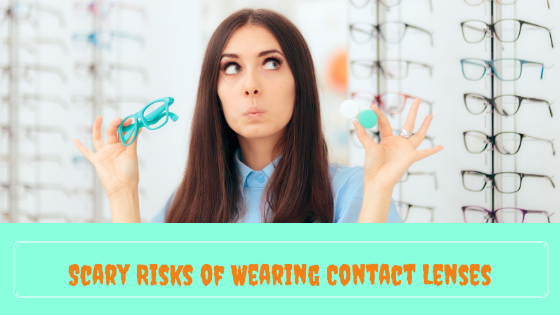“An estimated 45 million people in the U.S. wear contact lenses” – U.S. Food & Drug Administration (FDA) regulated medical devices – according to the Centers for Disease Control and Prevention (CDC). Although a more comfortable and convenient alternative to wearing eyeglasses, there are several scary risks involved with wearing contact lenses or more accurately, improperly wearing them.
Failure to follow your ophthalmologist’s instructions puts you at higher risk for infection and corneal abrasions. The CDC states that “between 40-90% of contact wearers do not properly follow the care instructions for their contact lenses. Also, serious eye infections that can lead to blindness affect up to one out of every 500 contact lens users per year.”
October has officially been declared Contact Lens Safety Awareness Month by Prevent Blindness. That seems incredibly fitting since October is also Halloween time. As October 31st approaches, trick-or-treaters and party-goers should seriously reconsider wearing non-prescription novelty contacts, also known as colored or decorative contacts. No costume is worth jeopardizing your vision!
The Boos of Wearing Contacts
Eye Infections
Infections are more likely to occur with unhygienic contacts. One of the most common types is infectious keratitis. It is a condition in which the cornea – the transparent dome covering the pupil and iris – becomes inflamed due to an invasion of germs. The symptoms of infectious keratitis include eye pain, red eye, excess tears or discharge, decreased vision, and sensitivity to light (photophobia).
Another common form of keratitis, albeit not an infection, can occur with contact overuse or if a foreign body enters the eye. Noninfectious keratitis can become infectious if medical treatment is delayed. If you experience any symptoms of an eye infection, promptly contact your ophthalmologist for diagnosis and treatment.
Corneal Abrasions
A scratch, or corneal abrasion, can happen during lens insertion or removal. Extended-use or rigid contacts may also result in abrasions. They can also be caused by small particles, such as dust or sand, getting underneath the contact. Because contact lenses move with your eye, dirt and debris can scrape the cornea, ultimately scratching it. Washing your hands before putting contact lenses in or taking them out is essential for preventing infections and scratches.
The symptoms of corneal abrasion include:
- Red, painful, watery eyes
- Blurry or hazy vision
- Eye irritation
- Photophobia
Treats for Your Eyes
Aside from never wearing contacts without a prescription, the FDA and CDC provide these tips to reduce the scary risks associated with wearing lenses.
- Thoroughly wash your hands before lens insertion or removal
- Do not expose them to any water (tap, bottled, distilled, etc.)
- Always follow your eye doctor’s wear and care instructions
- Avoid over wearing your contacts and NEVER sleep in them
- Do not swim or shower while wearing contacts
- Replace contacts and lens cases as recommended
- Use only fresh contact lens disinfecting solution
- Get a comprehensive eye exam each year
- See your ophthalmologist if you have:
- eye pain
- discomfort
- redness
- blurred vision
Whether you need to schedule an annual, comprehensive eye exam or you require surgical vision correction to treat cataracts or another eye disease, you can always expect to receive high-quality care at Eye Physicians of North Houston. Contact us today at (281) 893-1760 for more information or to schedule an appointment with one of our ophthalmologists.
Resources:
“Contact Lenses: Fast Facts.” The Centers for Disease Control and Prevention (CDC), 26 July 2018, www.cdc.gov/contactlenses/fast-facts.html.
“Contact Lens Risks” U.S Food & Drug Administration (FDA), 4 September 2018, www.fda.gov/medical-devices/contact-lenses/contact-lens-risks.
“More than 80 Percent of Contact Lens Wearers Are at Risk for an Eye Infection from Unsafe Use.” Prevent Blindness, 25 September 2018, www.preventblindness.org/more-80-percent-contact-lens-wearers-are-risk-eye-infection-unsafe-use.
“Protect Your Eyes.” The Centers for Disease Control and Prevention (CDC), 7 August 2019, www.cdc.gov/contactlenses/protect-your-eyes.html.

